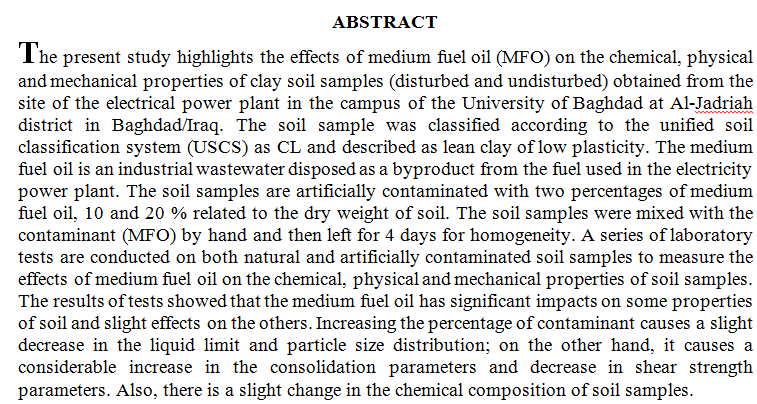
Radiological assessment for the East Baghdad oilfield-southern part was conducted in the current study. 10 samples (scale, soil, sludge, water, and oil) from the different stages of oil production were collected. 232Th, 226Ra, and 40K in the samples were analyzed with 40% efficiency for Gamma spectrometry. system based on HPGe. The findings indicated that the examined sites exhibit comparatively lower levels of NORM contamination, in contrast to other global oilfields. Nevertheless, certain areas, particularly those within separation stages, demonstrate relatively elevated NORM concentrations exceeding the global average in soil and sludge. The maximum value of 226Ra, 232Th, was found in sludge sample the findings indicated that ove
... Show More (1)
(1)
In this work, electrodialysis (ED) has been demonstrated to be appropriate technique for reducing the electrical conductivity of real wastewater from fuel washing unit, which has been previously treated by other electrochemical technology (electrocoagulation and electrooxidation). A five cell electrodialysis stack, with an active membrane area of 60 cm2 per cell was employed. During a batch recirculation mode ED system, the effects of parameters such as electrical potential applied (6-18 V) and flow rate of streams (0.5-1.7 L/min.) on the performance of the total dissolved solids (TDS) separation and specific power consumption (SPC) were studied. The results indicate that the process of ED under potential (15 V) and flow
... Show MoreThin films of (CdO)x (CuO)1-x (where x = 0.0, 0.2, 0.3, 0.4 and 0.5) were prepared by the pulsed laser deposition. The CuO addition caused an increase in diffraction peaks intensity at (111) and a decrease in diffraction peaks intensity at (200). As CuO content increases, the band gap increases to a maximum of 3.51 eV, maximum resistivity of 8.251x 104 Ω.cm with mobility of 199.5 cm2 / V.s, when x= 0.5. The results show that the conductivity is ntype when x value was changed in the range (0 to 0.4) but further addition of CuO converted the samples to p-type.
 (9)
(9)
 (10)
(10)
In This paper, CuO thin films having different thickness (250, 300 , 350 and 400) nm were deposited on glass substrates by thermal vacuum evaporator. The thermal oxidation of this evaporated film was done in heated glass at temperature (300 in air at one hour. The study of X-ray diffraction investigated all the exhibit polycrystalline nature with monoclinic crystal structure include uniformly grains. Thin film’s internal structure topographical and optical properties. Furthermore, the crystallization directions of CuO (35.54 , 38.70 ) can be clearly observed through an X-ray diffraction analysis XRD, Atomic Force Microscope AFM (topographic image) showed that the surface Characteristics , thin films crystals grew with increases in either
... Show MoreTo test the effect of 4 levels of nitrogen (i.e. 0, 45, 90 and 135 Kg N ha-1) as urea (46% N) and 3 levels of phosphorus (i.e. 0, 17.5 and 35 Kg P ha-1) as triple superphosphate (21.8% P) on yield and concentration of dill (Anethum graveolens L. local cultivar) seed oil this experiment was carried out during winter season of 1999 - 2000 at the experimental field of Agriculture College, Abu-Ghraib.
Both fertilizers were applied in two equal splits, first at seeds sowing and the second was added one month after emergence. Dried and ground seed samples were subjected to water distillation for extraction of volatile oils
Result indicated that fertilization of dill plants with 90 Kg N
... Show MoreZinc-air fuel cells (ZAFCs) are a promising energy source that could compete with lithium-ion batteries and perhaps proton-exchange membrane fuel cells (PEMFCs) for next-generation electrified transportation and energy storage applications. In the present work, a flow-type ZAFC with mechanical rechargeable was adopted, combined with an auxiliary cell (electrolyzer) for zinc renewal and electrolyte recharge to the main cell. In this work a practical study was performed to calculate the cell capacity (Ah), as well as study the electrolysis cell efficiency by current efficiency, and study the effective parameters that have an influence on cell performance such as space velocity and current density. The best parameters were selected to
... Show More (17)
(17)
 (13)
(13)
The bearing capacity of layered soil studies was carried out with various approaches such as experimental, theoretical, numerical, and combination of them. This work is focused on the settlement and bearing capacity of shallow foundations subjected to the vertical load placed on the surface of layered soils. The experimental part was performed by manufacturing soil cubic container (570 mm x 570 mm x 570 mm). A model square footing of width 60 mm was placed at the surface of the soil bed. The relative density of sand was constant at 60%, and the clay was prepared with a density of 19.2 (kN/m3) and water content of 14.6%. PLAXIS 3D FEM was used to simulate the experimental tests and performing a parametric study. The results showed
... Show More (3)
(3)
In this work, the effects of solvent properties on the characteristics of absorption and fluorescence for two laser dyes was studied. Dyes used in this work include Coumarin 5400 and DCM, while the solvents include ethanol, methanol, acetone, propanol and chloroform. Coumarin 5400 dye shows sharp fluorescence peaks in the green band of visible region while the DCM dye shows relatively wide band within 590-630 nm. Therefore, the selection of any dye for random gain medium applications should be performed after determining the most appropriate solvent as the optimum fluorescence characteristics are obtained.
 (1)
(1)
